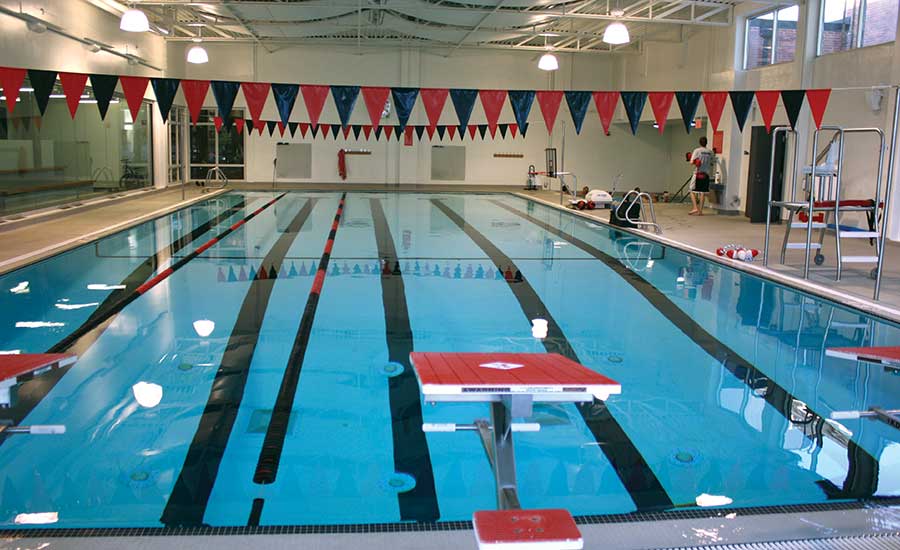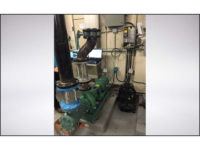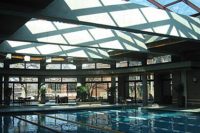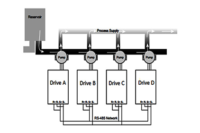Western Oregon University has been recognized as one of the top aquatic fitness programs in the United States. The recently enlarged Health and Wellness Center has also earned LEED Gold certification. Because of its dual commitment to aquatics and sustainability, the center jumped at the chance to dramatically cut the swimming pool’s electricity consumption with two Danfoss VLT® AQUA Drives.
“Being located in Monmouth, OR, our school prides itself on teaching swimming skills for lifelong fitness and recreation,” says Jake Whisenhunt, the university electrician who supervised the drive project. “It’s important to keep pool water clean for swimmers and to meet state regulations. At the same time, we want to reduce electricity costs and the carbon emissions associated with producing electricity. That’s why we were interested to learn that Danfoss variable frequency drives could dramatically cut the pool’s pump energy usage.”
Whisenhunt got the energy-saving idea from Neal Hershey, director of technical services for Interlocked Filtration Systems in Tacoma, WA. During a routine service call, Hershey suggested to Whisenhunt that equipping the pool pump motors with VSDs could substantially cut electricity costs.
“The center’s pool is used more for recreational swimming than competition,” explains Hershey. “The pool measures 25 yards long, five lanes wide, and holds 100,000 gallons of water. To meet state regulations, the water is cycled through a filtration system every six hours using a 15-hp inverter-rated circulation pump. A smaller spa holds 10,000 gallons, which is cycled every 30 minutes using a 10-hp pump. Together, the pumps use about 14,200 kWh per month at an annual cost of $11,200.”
According to Hershey, the original circulation pumps were equipped with soft motor starters only, which reduced the amperage draw during motor startup and motor wear. “But because the pumps were running full speed at 60 Hz all the time, they exceeded the water turnover rate required by the state. They were wasting energy.”
Hershey calculated that the pool could still meet state requirements by running the 15-hp pump at 49 Hz and the 10-hp pump at 47.2 Hz instead of 60 Hz — an average speed reduction of 19%.
He recommended installing a Danfoss VLT® AQUA Drive for each pump motor, which is designed to reduce pump motor speed by changing the frequency of electricity supplied to the pump motor.
“Reducing pump motor speed decreases power consumption exponentially,” explains Hershey. “Theoretically, according to pump affinity laws, a 50% speed reduction would cut energy consumption by 87.5%. Of course, we can’t cut pump speed by 50%; minimum water flow has to be maintained. Nevertheless, with Danfoss variable frequency drives, we can slow the pumps to match the required flow rate. In this case, pump speeds could be reduced an average of 19%
“Energy consumption went down further. In fact, electricity savings were nearly 25%. That’s because instead of running at 60 Hz and using 14,270 kWh per month, we could run an average of 48 Hz and cut electricity consumption 3,490 kWh per month.”
Energy is also saved by taking advantage of the pool’s filtration system’s auto-regeneration feature.
“The pool uses a Defender filtration system made by Neptune-Benson,” says Hershey.
The Defender system uses a unique filtration process. Once a day, the system turns on a pump to initiate a 10-minute regeneration process called the “pre-coat” cycle. The pressure induced by the pump causes particles of filter media, typically perlite, to attach to an array of flexible tubes. After 10 minutes, a valve is opened to allow the pool water to enter the filtration chamber, pass through the tubes, and return to the pool sparkling clean.
“The Defender system regenerates the media automatically,” Hershey explains. “During the filter pre-coat cycle, the controller uses the ‘jog’ speed feature programmed into the Danfoss VLT® Drive to reduce flow. The filter controller sends a signal to decrease pump speed during the daily pre-coat cycle. During those 10 minutes, the motors run at about 40 Hz. It’s not a long time nor a huge speed reduction, but the savings add up.”
By reducing speed to match the general flow rate and the pre-coat cycle requirements, the VLT® AQUA Drives save the center a total of $2,750 a year. As a result, the payback period for the VFD retrofit project was under two years.
According to Whisenhunt, there were operational benefits as well.
“In addition to ramping pump motor speed up and down, the variable frequency drives gave us a convenient remote start/stop feature,” he says. “For safety, a ‘no flow’ detection feature uses relay contacts to ensure no chemicals are fed into the pool water if the drive goes off line. Plus, everyone noticed that with the VLT® AQUA Drives, the motors are running much quieter than before.”




